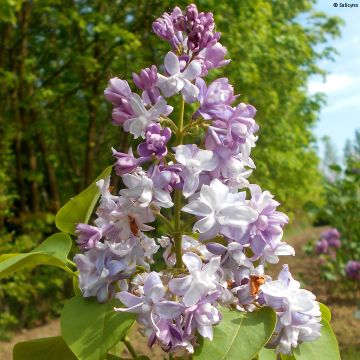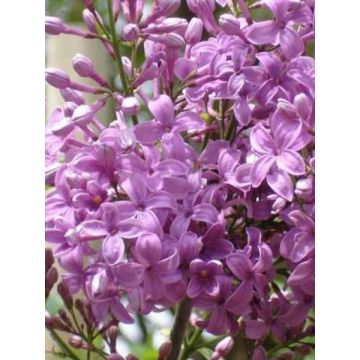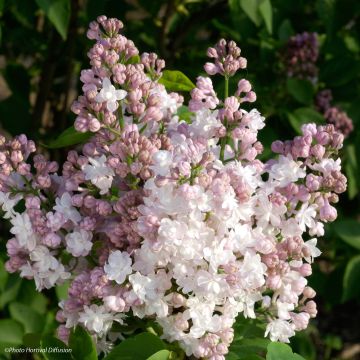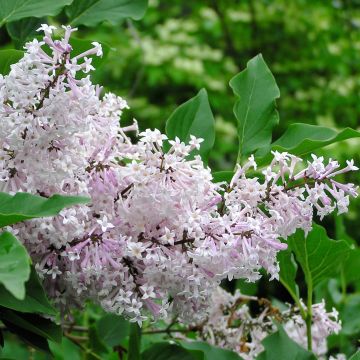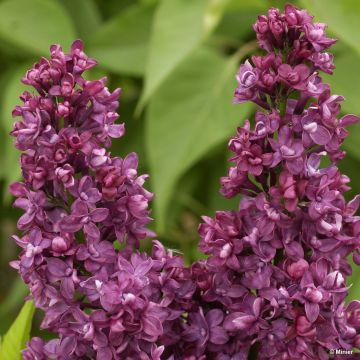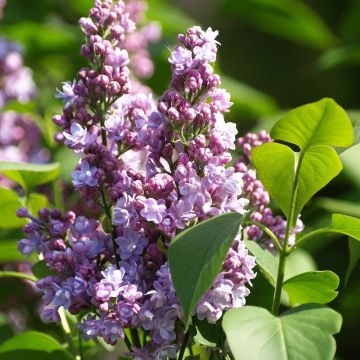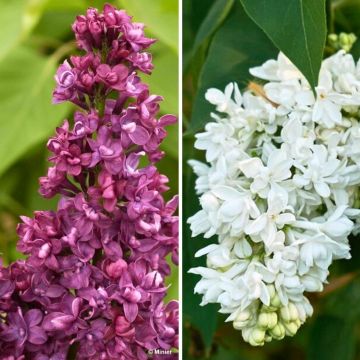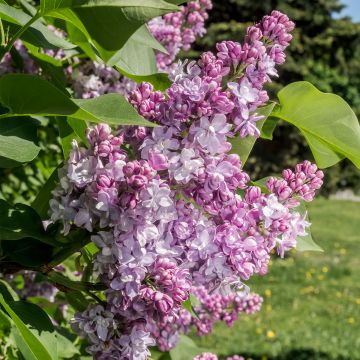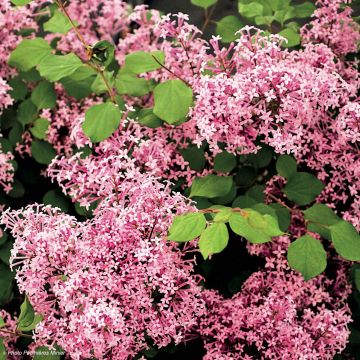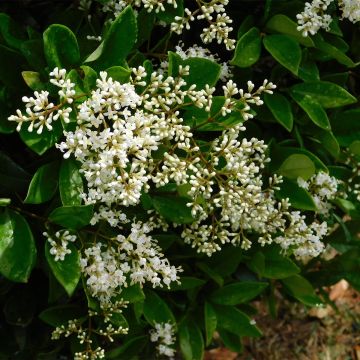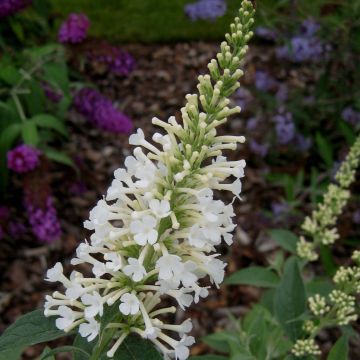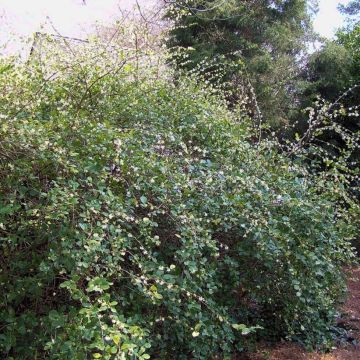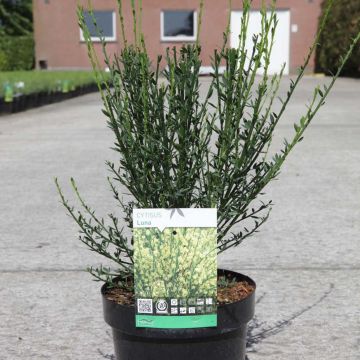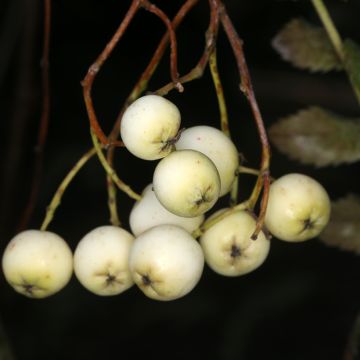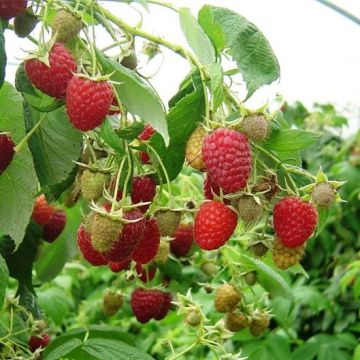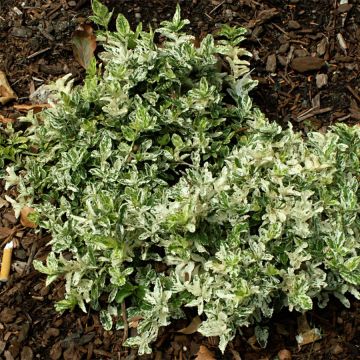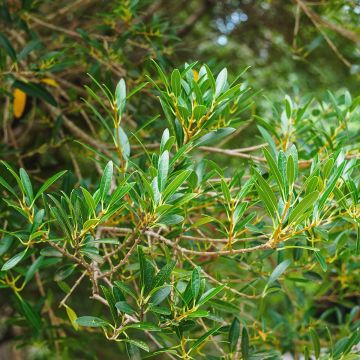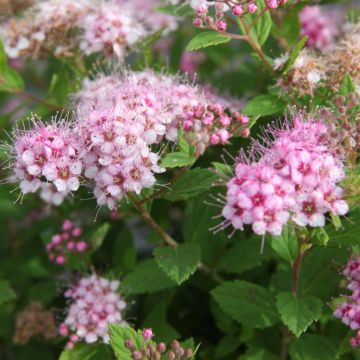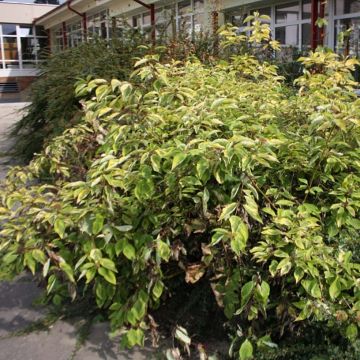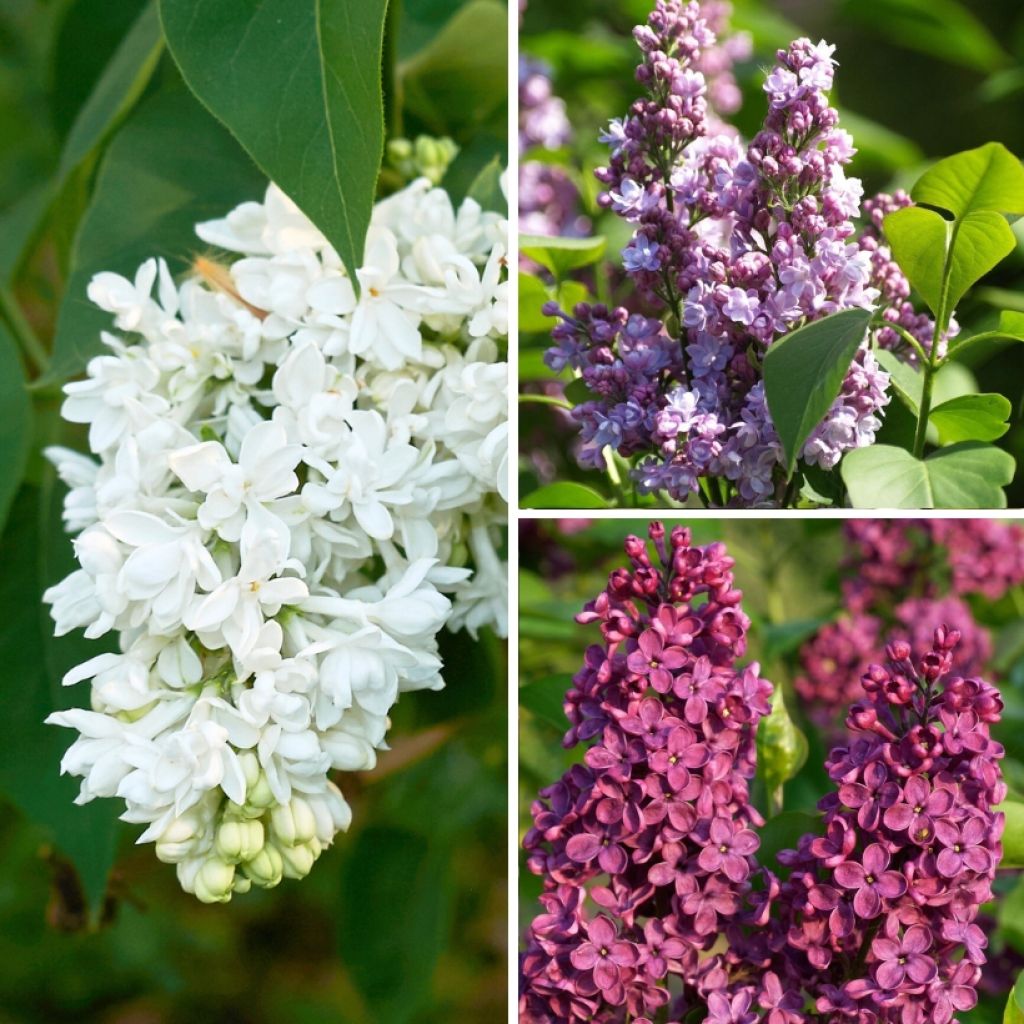

Syringa vulgaris Three Sisters (Michel Buchner, Ludwig Späht, Mme Lemoine) - Common Lilac
Syringa vulgaris Three Sisters (Michel Buchner, Ludwig Späht, Mme Lemoine) - Common Lilac
Syringa vulgaris Three Sisters ®
Common Lilac, Lilac
This plant carries a 24 months recovery warranty
More information
We guarantee the quality of our plants for a full growing cycle, and will replace at our expense any plant that fails to recover under normal climatic and planting conditions.
From €5.90 for pickup delivery and €6.90 for home delivery
Express home delivery from €8.90.
Does this plant fit my garden?
Set up your Plantfit profile →
Description
The common Lilac or Syringa vulgaris 'Three Sisters' is a combination of 3 varieties of different colors in the same pot to form one, like a bouquet of lilacs on a single bush. These are three old varieties from the late 19th century, renowned, appreciated and proven, which have been brought together. This lilac forms a small-sized bush, with clusters of fragrant flowers in white, mauve, and burgundy-purple corresponding to the Madame Lemoine, Michel Buchner, and Souvenir de Louis Spaeth varieties. The first two offer double flowers, further enhancing the possible color nuances since Madame Lemoine opens its white flowers from cream-colored buds and Michel Buchner produces red-purple buds that open into pinkish mauve flowers. As for Souvenir de Louis Spaeth, its burgundy-purple color, close to dark red, is rare.
The Syringa vulgaris 'Three Sisters' is a plant of a new genus while being a combination of varieties obtained between the 1880s and 1890s. The horticultural hybrids obtained in the late 19th century are very hardy bushes. They belong to the olive family, like their ancestor the common lilac, also known as European Lilac. Native to Southeast Europe and western Asia, specifically the Balkan Peninsula, it arrived in Western Europe at the end of the Renaissance. In nature, this indomitable plant with its very fragrant bluish-purple flowers colonizes rocky hills and braves cold winters. The hybrids are appreciated for their generous and fragrant flowering that perfumes the garden in spring on vigorously growing bushes. Plant it in the sun in a good and well-drained garden soil, even limestoney. Lilac clusters last a long time in a vase. Imagine that with the 'Three Sisters' lilac, you can create a bouquet with three colors and three varieties using just one plant.
The Three Sisters variety is a lilac that, over the years, forms a small tree with an erect habit, reaching an average height of 1.20 m (3 ft 11 in) and a spread of 1 m. It spontaneously develops into a bush composed of several stems, like the mock orange with which it should not be confused. Its stump produces suckers that sometimes need to be removed to maintain its beautiful appearance as a small tree. Its triangular and cordate leaves, 8 to 12 cm (3.1 to 4.7 in) long and 3 to 8 cm (1.2 to 3.1 in) wide, appear in spring in a tender green shade with a satin finish. Flowering takes place from April to May, earlier or later depending on the climate. At the end of one-year-old branches, paired compound clusters called thyrses appear, ranging from 10 to 30 cm (3.9 to 11.8 in) in length. Flower buds open into single or double flowers depending on the varieties. In double-flowered varieties, the entire inflorescence combines two colors: the buds are darker than the flowers. Their scent is quite powerful.
The strength emanating from the aged silhouette of a lilac, anchored on multiple trunks, as well as the generosity of its flowering, sometimes deserve a prominent place, as a standalone feature in a small garden. Surrounded by a bed of ground-cover roses and catmints, in a dedicated small space, this modest subject becomes a bush covered in glory in spring. Easy to grow in cool and relatively well-watered climates, even in the mountains, the common lilac thrives in ordinary, fresh, preferably limestone, but well-drained soils. Use it in large flowering hedges, together with single-flowered roses, mock oranges, amelanchiers, hawthorns, like Paul's Scarlet, Cotinus, or large buddleias (B. alternifolia). A lilac hedge, together with flowering cherries, Chinese almond, flowering plum, and ornamental apple trees, planted above a sunken path, is a true delight in spring.
Report an error about the product description
Plant habit
Flowering
Foliage
Botanical data
Syringa
vulgaris
Three Sisters ®
Oleaceae
Common Lilac, Lilac
Cultivar or hybrid
Other Syringa - Lilac
Planting and care
The Lilac appreciates planting in full sun, in a soil that remains fairly moist, well-drained, even a bit rocky. It can tolerate any type of soil, but prefers slightly calcareous soils and is afraid of strongly acidic soils. It will grow well in semi-shaded exposure, but the flowering will be slightly reduced. Its hardiness is excellent, beyond -15°C (5 °F). Easy to grow, it requires only mulching and regular watering in dry summer climates to maintain a certain level of moisture. While the common lilac grows happily in the south of our country, its large-flowered hybrids suffer from a lack of water which often disfigures their thirsty vegetation. In any case, water it during the first few years in case of marked drought. You can prune the flowering branches to make beautiful bouquets, or at the end of flowering to promote the appearance of new flowers and avoid tiring the bush. Avoid severe pruning that limits the flowering of the following spring, unless your Lilac becomes too large. Remove the shoots that form at the base of the bush if you want to maintain the appearance of a small tree.
Planting period
Intended location
Care
This item has not been reviewed yet - be the first to leave a review about it.
Hedge shrubs
Haven't found what you were looking for?
Hardiness is the lowest winter temperature a plant can endure without suffering serious damage or even dying. However, hardiness is affected by location (a sheltered area, such as a patio), protection (winter cover) and soil type (hardiness is improved by well-drained soil).

Photo Sharing Terms & Conditions
In order to encourage gardeners to interact and share their experiences, Promesse de fleurs offers various media enabling content to be uploaded onto its Site - in particular via the ‘Photo sharing’ module.
The User agrees to refrain from:
- Posting any content that is illegal, prejudicial, insulting, racist, inciteful to hatred, revisionist, contrary to public decency, that infringes on privacy or on the privacy rights of third parties, in particular the publicity rights of persons and goods, intellectual property rights, or the right to privacy.
- Submitting content on behalf of a third party;
- Impersonate the identity of a third party and/or publish any personal information about a third party;
In general, the User undertakes to refrain from any unethical behaviour.
All Content (in particular text, comments, files, images, photos, videos, creative works, etc.), which may be subject to property or intellectual property rights, image or other private rights, shall remain the property of the User, subject to the limited rights granted by the terms of the licence granted by Promesse de fleurs as stated below. Users are at liberty to publish or not to publish such Content on the Site, notably via the ‘Photo Sharing’ facility, and accept that this Content shall be made public and freely accessible, notably on the Internet.
Users further acknowledge, undertake to have ,and guarantee that they hold all necessary rights and permissions to publish such material on the Site, in particular with regard to the legislation in force pertaining to any privacy, property, intellectual property, image, or contractual rights, or rights of any other nature. By publishing such Content on the Site, Users acknowledge accepting full liability as publishers of the Content within the meaning of the law, and grant Promesse de fleurs, free of charge, an inclusive, worldwide licence for the said Content for the entire duration of its publication, including all reproduction, representation, up/downloading, displaying, performing, transmission, and storage rights.
Users also grant permission for their name to be linked to the Content and accept that this link may not always be made available.
By engaging in posting material, Users consent to their Content becoming automatically accessible on the Internet, in particular on other sites and/or blogs and/or web pages of the Promesse de fleurs site, including in particular social pages and the Promesse de fleurs catalogue.
Users may secure the removal of entrusted content free of charge by issuing a simple request via our contact form.
The flowering period indicated on our website applies to countries and regions located in USDA zone 8 (France, the United Kingdom, Ireland, the Netherlands, etc.)
It will vary according to where you live:
- In zones 9 to 10 (Italy, Spain, Greece, etc.), flowering will occur about 2 to 4 weeks earlier.
- In zones 6 to 7 (Germany, Poland, Slovenia, and lower mountainous regions), flowering will be delayed by 2 to 3 weeks.
- In zone 5 (Central Europe, Scandinavia), blooming will be delayed by 3 to 5 weeks.
In temperate climates, pruning of spring-flowering shrubs (forsythia, spireas, etc.) should be done just after flowering.
Pruning of summer-flowering shrubs (Indian Lilac, Perovskia, etc.) can be done in winter or spring.
In cold regions as well as with frost-sensitive plants, avoid pruning too early when severe frosts may still occur.
The planting period indicated on our website applies to countries and regions located in USDA zone 8 (France, United Kingdom, Ireland, Netherlands).
It will vary according to where you live:
- In Mediterranean zones (Marseille, Madrid, Milan, etc.), autumn and winter are the best planting periods.
- In continental zones (Strasbourg, Munich, Vienna, etc.), delay planting by 2 to 3 weeks in spring and bring it forward by 2 to 4 weeks in autumn.
- In mountainous regions (the Alps, Pyrenees, Carpathians, etc.), it is best to plant in late spring (May-June) or late summer (August-September).
The harvesting period indicated on our website applies to countries and regions in USDA zone 8 (France, England, Ireland, the Netherlands).
In colder areas (Scandinavia, Poland, Austria...) fruit and vegetable harvests are likely to be delayed by 3-4 weeks.
In warmer areas (Italy, Spain, Greece, etc.), harvesting will probably take place earlier, depending on weather conditions.
The sowing periods indicated on our website apply to countries and regions within USDA Zone 8 (France, UK, Ireland, Netherlands).
In colder areas (Scandinavia, Poland, Austria...), delay any outdoor sowing by 3-4 weeks, or sow under glass.
In warmer climes (Italy, Spain, Greece, etc.), bring outdoor sowing forward by a few weeks.

































